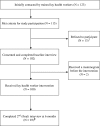Tailored lay health worker intervention improves breast cancer screening outcomes in non-adherent Korean-American women
- PMID: 18463411
- PMCID: PMC2654061
- DOI: 10.1093/her/cyn021
Tailored lay health worker intervention improves breast cancer screening outcomes in non-adherent Korean-American women
Abstract
Despite rapidly increasing incidence rates of breast cancer, recent immigrants such as Korean-American (KA) women report disproportionately lower utilization of screening tests compared with other ethnic groups. Early screening of breast cancer for this population may be greatly facilitated by indigenous lay health workers (LHWs). We conducted an intervention trial with a 6-month follow-up. Trained LHWs recruited 100 KA women 40 years of age or older who had not had a mammogram during the past 2 years. Ninety-three completed follow-up questionnaires. A 120-min, in-class education combined with LHW follow-up counseling and navigation assistance through the health care system was provided. Rates of breast cancer screening behaviors significantly increased at 6 months (P < 0.001); changes between pre- and post-intervention were 31.9% for mammography, 23% for clinical breast examination and 36.2% for breast self-examination. Modesty toward screening significantly decreased over time, but we did not find any significant differences in breast cancer knowledge and beliefs before and after the intervention. Results support the efficacy of this neighborhood-based, culturally sensitive intervention. Further research should seek to replicate these findings and to incorporate more self-care skills such as health literacy when designing an intervention program for linguistically and culturally isolated immigrant women.
Figures
Similar articles
-
Breast cancer screening among Vietnamese Americans: a randomized controlled trial of lay health worker outreach.Am J Prev Med. 2009 Oct;37(4):306-13. doi: 10.1016/j.amepre.2009.06.009. Am J Prev Med. 2009. PMID: 19765502 Free PMC article. Clinical Trial.
-
The effect of a couples intervention to increase breast cancer screening among korean americans.Oncol Nurs Forum. 2014 May;41(3):E185-93. doi: 10.1188/14.ONF.E185-E193. Oncol Nurs Forum. 2014. PMID: 24769601 Free PMC article. Clinical Trial.
-
Feasibility of a targeted breast health education intervention for Chinese American immigrant women.Oncol Nurs Forum. 2013 Jul;40(4):361-72. doi: 10.1188/13.ONF.361-372. Oncol Nurs Forum. 2013. PMID: 23803269 Clinical Trial.
-
Pre- and postintervention differences in acculturation, knowledge, beliefs, and stages of readiness for mammograms among Korean American women.Oncol Nurs Forum. 2009 Mar;36(2):E80-92. doi: 10.1188/09.onf.e80-e92. Oncol Nurs Forum. 2009. PMID: 19273397
-
An integrative review on breast cancer screening practice and correlates among Chinese, Korean, Filipino, and Asian Indian American women.Health Care Women Int. 2005 Mar;26(3):225-46. doi: 10.1080/07399330590917780. Health Care Women Int. 2005. PMID: 15804695 Review.
Cited by
-
Unpacking the 'black box' of lay health worker processes in a US-based intervention.Health Promot Int. 2020 Feb 1;35(1):5-16. doi: 10.1093/heapro/day094. Health Promot Int. 2020. PMID: 31916578 Free PMC article.
-
Discrimination and mental health-related service use in a national study of Asian Americans.Am J Public Health. 2010 Dec;100(12):2410-7. doi: 10.2105/AJPH.2009.176321. Epub 2010 Mar 18. Am J Public Health. 2010. PMID: 20299649 Free PMC article.
-
Mobile Phone Multilevel and Multimedia Messaging Intervention for Breast Cancer Screening: Pilot Randomized Controlled Trial.JMIR Mhealth Uhealth. 2017 Nov 7;5(11):e154. doi: 10.2196/mhealth.7091. JMIR Mhealth Uhealth. 2017. PMID: 29113961 Free PMC article.
-
Components and effectiveness of patient navigation programmes to increase participation to breast, cervical and colorectal cancer screening: A systematic review.Cancer Med. 2023 Jul;12(13):14584-14611. doi: 10.1002/cam4.6050. Epub 2023 May 28. Cancer Med. 2023. PMID: 37245225 Free PMC article.
-
Telemedicine and Access to Elective Cholecystectomy for Socially Vulnerable Adults: A Pilot Randomized Clinical Trial.JAMA Netw Open. 2024 Oct 1;7(10):e2438137. doi: 10.1001/jamanetworkopen.2024.38137. JAMA Netw Open. 2024. PMID: 39382898 Free PMC article. Clinical Trial.
References
-
- American Cancer Society. Cancer Facts and Figures 2008. Atlanta, GA: American Cancer Society; 2008.
-
- Surveillance, Epidemiology, and End Results (SEER) Program. SEER*Stat Database: Incidence—SEER 17 Regs Public-Use, Nov 2005 Sub (2000–2003) Available at: http://seer.cancer.gov/faststats/sites.php?site=Breast+Cancer&stat=Incid.... Accessed: 7 June 2007.
-
- Deapen D, Liu L, Perkins C, et al. Rapidly rising breast cancer incidence rates among Asian American women. Int J Cancer. 2002;99:747–50. - PubMed
-
- Ministry of Health and Welfare. Annual Report of the Central Cancer Registry in Korea 2001. Available at: http://www.mohw.go.kr/services/service.jsp?itn=tbdata&sa=11&sno=3409&bun.... Accessed: 21 November 2007.
-
- McCracken M, Olsen M, Chen MS, Jr, et al. Cancer incidence, mortality, and associated risk factors among Asian Americans of Chinese, Filipino, Vietnamese, Korean, and Japanese ethnicities. CA Cancer J Clin. 2007;57:190–205. - PubMed
Publication types
MeSH terms
Grants and funding
LinkOut - more resources
Full Text Sources
Medical
Miscellaneous


